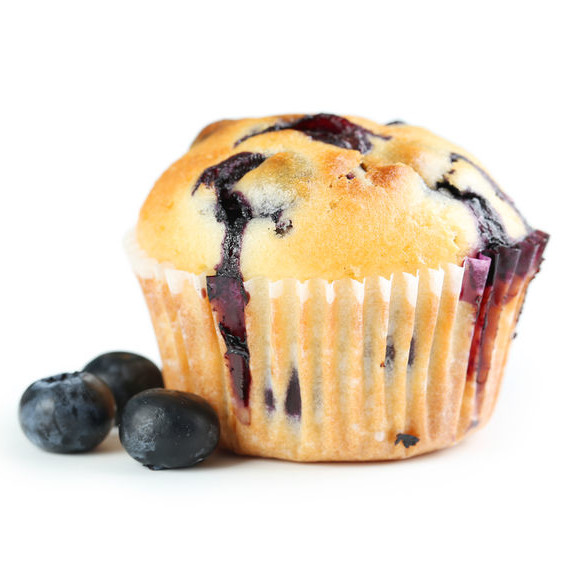
Muffins
What are Muffins?
A muffin is a chemically-leavened, batter-based bakery product. It’s formulation is somewhere in between a low-ratio cake and quick bread. Muffin batter is typically deposited or placed into deep, small cup-shaped pan before baking. This gives the finished product a special “cupcake” or “mushroom-like” shape.1,2
Characteristics of muffins include:
- Moist crumb
- Chewy texture
- Uneven crumb grain with holes or tunnels throughout
- Peaked (bell-type) or flat tops
Origin
The origin of muffins appears to be unclear and greatly depends on who and where the question is asked. The ones consumed in the UK have been traditionally known as english muffins. However, these differ from the popular muffins that are consumed in the U.S., South America and other regions of the world.1,2
Muffins have become a very popular alternative to the breakfast Danish and doughnut. They have gained acceptance as snack items in between meals, as desserts and even dinner additions.
Function1,2
They are the meeting point between bread and cakes. As with cakes, the type of flour, baking powder and batter consistency greatly affect product characteristics. The following is a formulation for low-ratio muffins with the possibility of incorporating inclusions.
| Ingredients | Baker’s % (based on flour weight) |
| All-purpose flour, hard/soft wheat flour blends* | 100.0 |
| Salt | 1.5–2.5 |
| Sugar (refined and granulated sucrose) | 55.0–65.0 |
| Nonfat dry milk | 5.0–15.0 |
| Baking powder** | 4.0–6.0 |
| Liquid whole eggs*** | 25.0–35.0 |
| Water**** | 55.0–65.0 |
| All-purpose shortening | 40.0–50.0 |
| Modified starches | 0.0–3.0 |
| Gums | 0.1–0.5 |
| Emulsifiers | 0.0–3.0 |
| Inclusions
(blueberries, raisins, chocolate chips, nuts) |
15.0–20.0
(based on batter weight) |
*Muffins with inclusions require more viscous batters to prevent pieces from settling during processing. Chlorine-treated cake flour or stronger flours are recommended for ones with inclusions.
**Common used leavening acids include: SAPP-28, MCP-SALP, MCP-SAS (double-acting blends)
***Whole egg powder can also be used.
****Water in formula must be adjusted (increased) to compensate for the moisture provided by liquid whole eggs.
Processing of batter1,2
- Ingredient scaling.
- Mixing (batter mixing using the muffin method)
- Combine all dry ingredients
- Combine all liquid ingredients
- Add liquids to dry ingredients and mix at low speed to form a homogeneous batter.
- Add inclusions and incorporate gently into batter to prevent them from breaking and releasing juices.
- Batter should be immediately processed to avoid loss of carbon dioxide gas that may cause poor volume in the finished product.
- Depositing or panning.
- Depositor: piston-type depositors are recommended given their gentle handling of inclusions and excellent portioning accuracy and scaling weight consistency.
- Pan size: standard cupcake pan (2 ¾ inch top diameter, 2 inch base, with 1 ½ inch depth).
- Baking. Bake at 350–425°F (177–218°C) to an internal temperature of 204°F (95°C). This usually takes 25–35 minutes. The higher the oven temperature, the shorter the baking time.
- Cooling to loaf internal temperature of 95–105°F (35–40°C) before packaging or serving.
- Packaging or serving
Continuous mixing of muffin batter
Continuous mixing equipment and slurry mixers for the production of muffins are widely used in high-speed bakeries. Process parameters such as rotor speed, air injection (air pressure regulator), slurry pump speed and back pressure must be properly set. Also, control for optimum batter aeration, homogenization, temperature and viscosity.
Application
- The richer the muffin formula, the more tender the product texture and the longer the shelf-life.
- The addition of hydrocolloids such as instant starch and gums enhances the stability of the batter by improving bench tolerance and increasing viscosity. They also produce a more moist and chewy crumb. These ingredients help keep inclusions from sinking.
- Muffins shape is controlled by batter viscosity, baking temperature and chemical leavening system.
- Peaked muffins are obtained from stiffer and much thicker batters formulated with stronger flours and/or less hydration levels, higher oven temperatures and lower scaling weight relative to pan cup size.
- Flat top muffins, on the contrary, are obtained from more fluid batters. These are formulated with weaker flours, more sugar and fat, and/or higher hydration levels. Also, higher oven temperatures and lower scaling weight relative to pan cup size play a role.
- Using faster-acting baking powder produces a more flat shape while slower-acting systems produce more peaked or bell-type shape.
Differences between muffins and cupcakes
- Muffins are made up of less rich formulas (usually lower fat and sugar content)
- Glazings/icings are not typically used with muffins
Differences between muffins and English muffins
- English muffins are round yeast-leavened and dough-based products
- English muffins are cooked (baked) on a hearth or griddle
References
- Serna-Saldivar, S.O. “Production of Chemical-Leavened Products: Crackers, Cookies, Cakes and Related Products, Donuts, and Wheat Flour Tortillas.” Cereal Grains: Laboratory Reference and Procedures Manual, CRC Press, Taylor & Francis Group, LLC, 2012, pp. 261–262.
- Ortiz, D.E. “Cakes, Muffins and Bagels.” Encyclopedia of Food Grains, 2nd edition, Volume 3 Grain-Based Products and their Processing, Academic Press, Elsevier Ltd., 2016, pp. 30–36.

